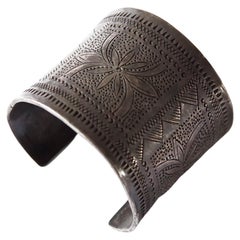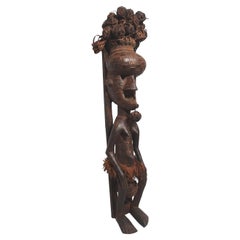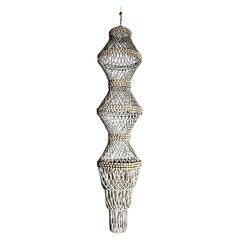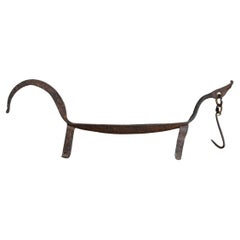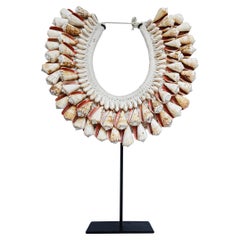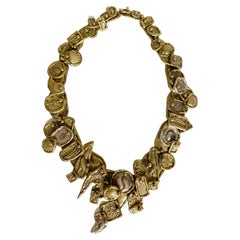Hand-Crafted Tribal Art
to
50
177
81
290
3
1
36
8
4
18
28
244
4
90
74
21
2
1
5
2
1
1
5
8
5
1
107
94
47
38
36
151
95
67
51
46
294
293
294
40
2
1
1
1
Technique: Hand-Crafted
Antique Thai Hill Tribe Cuff Bracelet with Engraved Tribal Patterns
Located in Jimbaran, Bali
This Thai hill tribe silver bracelet is beautifully engraved with tribal motifs. The Thai Silver Jewellery created by the Hill Tribes are objects o...
Category
Early 20th Century Thai Tribal Hand-Crafted Tribal Art
Materials
Silver
African Art Statue "Fertility Figure"
Located in Norton, MA
A precious African Art Statue with oven balls for hair, basket weave texture on the face, and wearing a loin cloth. The brass panels are applied on ...
Category
Early 20th Century African Hand-Crafted Tribal Art
Materials
Wood
Folk Style Filipino Hanging Talisman Or Outdoor Chandelier
Located in Prato, Tuscany
We kindly invite you to read the full description below, as it contains detailed technical and historical information to ensure the authenticity and value of our pieces.
An original ...
Category
Late 20th Century Philippine Folk Art Hand-Crafted Tribal Art
Materials
Metal
20th Century-African, Iron Object Made by the Lobi Tribe of Burkina Faso, Africa
Located in Sammu-shi, Chiba
An iron figurine made in Africa around the 20th century.
In many countries in Africa, iron objects are used for objects, coins, tools, and rituals.
Dogo...
Category
20th Century Burkinabe Tribal Hand-Crafted Tribal Art
Materials
Iron
Cone Shell Necklace on Stand, Papua New Guinea
Located in New York, NY
A male necklace from the Asmat Village, Papua New Guinea.
Large cone shells in concentric rows, seamlessly sewn onto a cotton macrame base, which has been hand-knotted around a sem...
Category
2010s Indonesian Tribal Hand-Crafted Tribal Art
Materials
Shell, Cotton, Bamboo
Vintage Pal Kepenyes Bronze/Brass Necklace, 20th Century
By Pal Kepenyes
Located in Point Richmond, CA
Vintage Pal Kepenyes bronze/brass necklace, 20th century.
This Hungarian born artist worked in Mexico for decades, known for free-form sculptural jewelry...
Category
20th Century Mexican Modern Hand-Crafted Tribal Art
Materials
Brass, Bronze
$760 Sale Price
20% Off
Indonesian 'Wayang Golek" Shadow Puppet, Java, Indonesia, Early 20th Century
Located in Jimbaran, Bali
This “Wayang Golek” is a visibly old shadow puppet carved using soft wood and cloth. It features an articulated head and arms connected to rods, the dress...
Category
Early 20th Century Indonesian Tribal Hand-Crafted Tribal Art
Materials
Wood, Fabric
$516 Sale Price
20% Off
Pre Columbian Rare Lambayeque Wood Figure
Located in London, GB
Pre columbian Lamabayeque wood figure Peru Circa 750 to 1375 AD
A rare standing figure of a deity with triangular tear drop shaped eyes holding a child,
Carved in very dense heavy hard wood
Measures: Height 14 inches, 36 cm weight, 1.5 kg approx
Ex collection of a Oxford Academic, reputed to have came from Pit rivers...
Category
15th Century and Earlier Peruvian Antique Hand-Crafted Tribal Art
Materials
Wood
Antique Decorative Moroccan Arabian Jambiya
Located in Moreno Valley, CA
Antique decorative Moroccan Arabian khoumaya or Jambiya, which is the name in Arabic Ornate with brass and silvered steel hammered element and wood handle. The decorative dagger is v...
Category
Mid-20th Century Moroccan Islamic Hand-Crafted Tribal Art
Materials
Metal, Brass
Tribal Early 20th Century Ceremonial Pipe, Bamoun People, Cameroon
Located in Point Richmond, CA
Tribal Early 20th Century Ceremonial Pipe, Bamoun People, Cameroon
A ceremonial tobacco pipe fashioned of hardened clay depicting three bearded men, the center figure with arms on c...
Category
Early 20th Century Cameroonian Tribal Hand-Crafted Tribal Art
Materials
Wood
Aboriginal Desert Shield Red Pigment Fine Incised Lines Australia on Stand
Located in Point Richmond, CA
Early to mid-20th century Aboriginal Desert Shield of lightweight wood with finely incised carved vertical lines on front and back, encrusted red pigment, simple curved oval shape, b...
Category
Mid-20th Century Australian Tribal Hand-Crafted Tribal Art
Materials
Organic Material
Antique Prestige Basket, Tanzania
Located in Point Richmond, CA
Prestige open top basket
Sukuma People (?) Tanzania
Circa 1900
Coiled and woven basketry, natural fibers and dye
8 x 6 1/2 inches (21 x 16.5 cm)
Provenance: ex private collection U...
Category
Early 1900s Tanzanian Tribal Antique Hand-Crafted Tribal Art
Materials
Natural Fiber
1995 Hopi Kachina Doll, Aholi
By John Booth
Located in Tarrytown, NY
1995 Hopi Kachina Doll - Aholi on wood base
Matte and Glazed in ceramic (heavy)
Feather missing on one ear muff
The perfect addition to any Kachina D...
Category
1990s Unknown Native American Hand-Crafted Tribal Art
Materials
Ceramic
Early Papua New Guinea Sepik Light Wood Yam Mask Elegant Flame Shaped Form
Located in Point Richmond, CA
Early Papua New Guinea Sepik light wood yam mask. Elegant flame shaped form, old, oxidized wood with black accents, traces of yellow and white pigments. Small...
Category
Mid-20th Century Papua New Guinean Tribal Hand-Crafted Tribal Art
Materials
Organic Material, Wood
Two Tribal Bronze Konga Anklet Leg Band
Located in Moreno Valley, CA
An early 20th century antique African tribal leg band (ankle bracelet),
These leg bands were both currency and status symbols for the Mongo tribe of northwest Congo.
They were ma...
Category
Early 20th Century Congolese Folk Art Hand-Crafted Tribal Art
Materials
Bronze
$1,850 / set
20th Century Bark Cloth Painting, Mbuti 'Efe' People, D.R. Congo
Located in Point Richmond, CA
20th Century bark cloth painting, Mbuti (Efe) people, Ituri Forest, D. R. Congo
A painted barkcloth from the Efe people in the Ituri forest of no...
Category
1970s Congolese Tribal Vintage Hand-Crafted Tribal Art
Materials
Natural Fiber
African Tuareg Silver Pewter Tea Pot from Mauritania
Located in Moreno Valley, CA
Vintage African Tuareg Tea pot Mauritania
Mid-20th century Tuareg teapot from Mauritania, Africa, Western Sahara.
Handcrafted of pewter, copper and brass...
Category
Mid-20th Century Mauritanian Folk Art Hand-Crafted Tribal Art
Materials
Brass, Copper, Pewter
Indonesian 'Wayang Kulit" Shadow Puppet, Java, Indonesia, Early 20th Century
Located in Jimbaran, Bali
This flat shadow puppet was crafted on the island of Java by a puppet artist using buffalo hide and mounted on bamboo sticks. It was used in Wayang puppet...
Category
Early 20th Century Indonesian Tribal Hand-Crafted Tribal Art
Materials
Leather, Wood
Ashanti Bronze Ceremonial Staff Top Hoe with 3 Turtles, Ghana
Located in Point Richmond, CA
Ashanti cast bronze ceremonial staff top in the shape of a hoe with 3 cast turtles, from Ghana.
It is in good condition with a deep patina and polish from traditional use, appropria...
Category
Mid-20th Century Ghanaian Tribal Hand-Crafted Tribal Art
Materials
Bronze
Conical Hat Mornington Island, Queensland Australia Woven Fiber on Stand
Located in Point Richmond, CA
Early to mid-20th century woven fiber and palm leaf conical hat with two vertical painted stripes on the front, from Mornigton Island, Queensland, Austral...
Category
Mid-20th Century Australian Tribal Hand-Crafted Tribal Art
Materials
Organic Material
$900 Sale Price
40% Off
Berber Stone Necklace, Early 20th Century
Located in New York, NY
A long Berber necklace, hand-crafted with stone beads and wool, with a round filigree silver accent. Morocco, early 20th Century.
Green and blue amazonite, red coral, glass and sto...
Category
1920s Moroccan Tribal Vintage Hand-Crafted Tribal Art
Materials
Stone, Silver
$270 Sale Price
40% Off
Old Stone Axe With Carved Face, Pierced Nose, Papua New Guinea on custom Base
Located in Point Richmond, CA
Early hand carved stone axe with face, long nose with pierced nostrils, framed by loose oval form. Round eyes and slit mouth. Old worn surface.
8 1/2 inches high, early to mid 20th...
Category
Mid-20th Century Papua New Guinean Tribal Hand-Crafted Tribal Art
Materials
Stone
Berber Copal Amber and Silver Necklace, Early 20th Century
Located in New York, NY
A long Berber necklace, hand-crafted with Copal amber large beads and silver accents. Morocco, early 20th Century.
Copal amber is a tree resin similar to amber but not fully fossil...
Category
1920s Moroccan Tribal Vintage Hand-Crafted Tribal Art
Materials
Silver
$520 Sale Price
20% Off
Old Toraja Group of three Basketry Wrapped Coconut Containers, Indonesia
Located in Point Richmond, CA
Group of three pieces. Two old used finely wrapped basketry enclosed coconut containers and one cup from the island of Toraja, Indonesia. The tall one has a flat wood stopper with classic Toraja designs, Early to mid 20th century or earlier, with deep dark patina from traditional use. Evidence of wear and use, smaller container with carved wood top attached by string.
Last view...
Category
Mid-20th Century Indonesian Tribal Hand-Crafted Tribal Art
Materials
Organic Material
Mid-20th Century Ceremonial Comb, Luba People, Zaire, D. R. Congo
Located in Point Richmond, CA
Ceremonial comb, Luba People, Zaire, D. R. Congo
Made of palm leaf midribs, this large, graphic comb has a pinched waist and is held together with finely wrapped wire. Presented o...
Category
Mid-20th Century Congolese Tribal Hand-Crafted Tribal Art
Materials
Wire
Woven Painted Basketry Old Yam Helmet Mask Sculptural Face Papua New Guinea
Located in Point Richmond, CA
Woven painted basketry yam helmet style mask from Papua New Guinea. Hollow woven form with traces of red and white pigments. Would have been put on top of a large yam as a part of th...
Category
Mid-20th Century Papua New Guinean Tribal Hand-Crafted Tribal Art
Materials
Organic Material
$617 Sale Price
35% Off
African Yoruba Diviner's Red Beaded Sash Panel 1950
Located in Moreno Valley, CA
African Yoruba Diviner's Red Beaded Wall Hanging Panel Sash 1950.
This extraordinary beaded wall hanging is a stunning example of Yoruba craftsmanshi...
Category
Mid-20th Century Nigerian Folk Art Hand-Crafted Tribal Art
Materials
Textile, Beads
African Tuareg Hand-Tooled Leather Pillow with Fringes
Located in Moreno Valley, CA
Large African Tuareg hand tooled leather pillow.
Great colors, hand painted with tribal geometric design with long leather fringes on each side.
Handcrafted in Africa with pieces of ...
Category
Mid-20th Century Kenyan Tribal Hand-Crafted Tribal Art
Materials
Leather
Woven Painted Basketry Old Yam Mask with Sculptural Bird Face, Papua New Guinea
Located in Point Richmond, CA
Early woven painted basketry yam mask from Papua New Guinea. Bug eyed or bird faced mask with heavy incrustation from many years of use, a striking mask that ...
Category
Mid-20th Century Papua New Guinean Tribal Hand-Crafted Tribal Art
Materials
Organic Material
$942 Sale Price
35% Off
Old Toraja Tall Bamboo Rice Container with Wood Top, Indonesia
Located in Point Richmond, CA
Old well used tall rice container carved from bamboo, with wood top from the island of Toraja, Indonesia. Early to mid 20th century or earlier, with deep dark patina from traditiona...
Category
Mid-20th Century Indonesian Tribal Hand-Crafted Tribal Art
Materials
Organic Material
African Tuareg Tea Pot Mauritania
Located in Moreno Valley, CA
Mid-20th century Tuareg tea pot from Mauritania, Africa, Western Sahara.
Handcrafted of pewter, copper and brass decorations.
The Tuareg people inhabit a large area, covering almost ...
Category
Mid-20th Century Mauritanian Folk Art Hand-Crafted Tribal Art
Materials
Brass, Copper, Pewter
Handpainted Moroccan Folk Art Decorative Wall Sconce
Located in Moreno Valley, CA
African Tribal Art parchment wall shade sconce featuring a large curved hide form stitched on iron and hand painted surface.
These Moroccan Art pieces could be used as wall lamp sha...
Category
20th Century Moroccan Folk Art Hand-Crafted Tribal Art
Materials
Iron
1989 Hopi-Tewa Painted Pottery Canteen by Jean Sahme Nampeyo with Kokopelli
Located in Denver, CO
This exquisite painted pottery canteen, crafted by renowned Hopi-Tewa artist Jean Sahme Nampeyo (b. 1949), is a stunning blend of traditional Hopi pott...
Category
1980s American Native American Vintage Hand-Crafted Tribal Art
Materials
Ceramic, Clay
Antique African Tuareg Red Black and Brown Leather Bag
Located in Moreno Valley, CA
Vintage African Tuareg red, black and brown leather bag with fringes.
A great old fringed leather bag from the Tuareg sourced in Mali.
Handcrafted by the Tuareg women in Mali Africa ...
Category
Mid-20th Century Malian Tribal Hand-Crafted Tribal Art
Materials
Leather
Large Woven Painted Basketry Wall Mask Blackwater Rivers, Papua New Guinea
Located in Point Richmond, CA
Large woven painted basketry wall mask created in Blackwater Rivers area, Papua New Guinea. With open expressive mouth and mask fringed with feathers, striking mask that easily hang...
Category
Mid-20th Century Papua New Guinean Tribal Hand-Crafted Tribal Art
Materials
Organic Material
$1,715 Sale Price
30% Off
A Kayapo Amazon Indigenous feather headdress
Located in Amsterdam, NL
Brazil, Pará, circa 1950s-1960s
H. 97 x W. 106 cm
Provenance:
Collection Rinck Hollnberger, Munich
(purchased in the 1980s)
Category
20th Century Brazilian Hand-Crafted Tribal Art
Materials
String, Feathers
Northern Thailand Tribal Headdress, Mid-Century
Located in Point Richmond, CA
An Ulo Akha woman's Tribal headdress made from a framework of bamboo, and adorned with beads, pompoms, seeds and other unique items. This piece offers a peek into the rich cultural tapestry of Northern Thailand...
Category
Mid-20th Century Thai Tribal Hand-Crafted Tribal Art
Materials
Bamboo, Beads, Fabric
Early Hardwood Mexican Mask, Man With Moustache and Beard early 20th century
Located in Point Richmond, CA
Early hardwood Mexican mask, representing a man with moustache and beard with curly hair on forehead. Strong, sharp carving with high relief detaisl. Heavy staining and wear inside...
Category
Mid-20th Century Mexican Tribal Hand-Crafted Tribal Art
Materials
Organic Material
$1,160 Sale Price
20% Off
Yoruba Nigeria African Red Royal Beaded Headdress Crown on Lucite Stand
Located in Moreno Valley, CA
West African hand beaded head dress crown from Yoruba, Nigeria.
This artistic beautiful and functional art piece is covered with beads in ivory, red and black colors with faces bird...
Category
Mid-20th Century Nigerian Tribal Hand-Crafted Tribal Art
Materials
Metal
Early Pende Giwoyo Mask with Strong Face and Woven Black Raffia Hair Cap
Located in Point Richmond, CA
Old Pende giwoyo mask with traces of yellow, black and red pigments and woven black raffia hair cap. Strong face with tight expression, weathered surface, goo...
Category
Mid-20th Century Congolese Tribal Hand-Crafted Tribal Art
Materials
Organic Material, Wood
$3,150 Sale Price
30% Off
Antique Ethnic Artifact Sepik River Cassowary Bone from Papua New Guinea
Located in Moreno Valley, CA
Antique Ethnic Artifact Sepik River Cassowary Bone from Papua New Guinea
For many groups in Papua New Guinea, bone was an important medium for making tools of all types. This artifact is made from leg bone of a cassowary, a large, flightless, and extremely dangerous, bird.
Cassowaries also play an important role in the mythology of groups in the Sepik River area.
Though no longer used these bone artifacts are still used ceremonially. They often play important roles in male initiation and other rituals. They are also worn as personal adornment by tucking them into a band of braided fibers worn around the upper arm.
Antique Ethnic Bone Cassowary Artifact with minimal carving and incised design confined to the joint end.
A small hole has been drilled through from both sides of the top and presumably for the threading of a cord.
The bone has been partially divided near the top and to form two prongs that project down the back of the dagger possibly allowing the user to wear is tuck into a waist band or belt.
Origin Papua New Guinea Maprik Dist Area
From the Art Collection of Marian and John Scott, acquired in 1962.
Similar items are in display in the Timothy S. Y. Lam Museum of Anthropology.
Purchased from the amazing private collection of Mark Lissauer who spent his life collecting niche ethnographic pieces.
About Mark Lissauer:
Mark Lissauer spent forty years travelling abroad for months at a time collecting ethnographic artefacts primarily from New Guinea and the islands of the West Pacific, and from Asia and Himalayan countries. Fluent in five languages and having in the course of business travelled to more than forty countries, Mark is well-known to museums and art-collectors around the world for his long career and his interesting and diverse collection of rare ethnographic material.
Mark knows the origin and symbolism of each piece. Through extensive research and more than ninety trips around the globe, Mark familiarised himself with the traditions of the various cultures he visited in order to understand the meaning of each object to its region and tribe. His home has a specialist library and several rooms are filled with tribal carvings, textiles and ethnographica.
He acquired his first tribal piece in 1948 during a business trip to Milne Bay, New Guinea, and has since documented the acquisition of some 35,000 items. Several thousands of these have been sold to important private collections and museums worldwide, including the Rockefeller Museum, the British Museum and the Musée National des Arts d’Afrique et d’Océanie, now incorporated into the Louvre Museum.
Estimator certificate of authenticity by Wayne Heathcote Tribal Art Dealer and Expert.
Heathcote has a flash gallery in Brussels, where much of the tribal art business is centred, and is an expert at Sotheby's tribal art sale...
Category
Early 20th Century Folk Art Hand-Crafted Tribal Art
Materials
Bone
Pair of Authentic Bronze African Currency Cuffs
Located in Wainscott, NY
African currency bracelet made of bronze, with a rich patina.
Category
Early 20th Century Hand-Crafted Tribal Art
Materials
Brass
Early Papua New Guinea Sepik Woven Yam Mask Yellow Pigments on Custom Base
Located in Point Richmond, CA
Early Papua New Guinea Sepik River area tightly woven raffia yam mask with areas of heavy yellow and black pigments. In profile small bird beak form at bottom...
Category
Mid-20th Century Papua New Guinean Tribal Hand-Crafted Tribal Art
Materials
Organic Material
Moroccan Antique Brass Sugar Hammer
Located in Moreno Valley, CA
Set of two Moroccan brass Berber tribal sugar hammer.
Moroccan Collectible Brass Berber Sugar Hammer,Brass Berber Tribal Sugar Hammer.
Authentic old Tuare...
Category
Early 20th Century Moroccan Folk Art Hand-Crafted Tribal Art
Materials
Brass
$1,350 / set
Late 19th-Early 20th Century Tribal Terracotta Bottle, Djenne Area, Mali
Located in Point Richmond, CA
Late 19th-Early 20th century tribal terracotta bottle, Djenne Area, Mali
A handsome terracotta bottle from the Djenne area of Mali with incised geometric patterns on the globular ...
Category
Early 20th Century Malian Tribal Hand-Crafted Tribal Art
Materials
Terracotta
$600 Sale Price
20% Off
Nias 'Kalabubu' Coconut & Brass Headhunter Necklace
Located in Jimbaran, Bali
This 'Kalabubu' necklace, also known as the 'head-hunter' necklace made out of coconut and brass is the most important ornament for the men of Southern Nias Island, North Sumatra...
Category
Early 20th Century Indonesian Tribal Hand-Crafted Tribal Art
Materials
Brass
Female Kifwebe Mask with old collection label, Luba-Songye People, DR Congo
Located in Leuven , BE
Traditionally, Kifwebe masks were created and worn by members of the secret masking society, Bwadi Bwa Kifwebe, of the Luba and the Songye People living in the central part of the Co...
Category
20th Century Congolese Hand-Crafted Tribal Art
Materials
Wood
An Amazon Indigenous Kayapo feather headdress
Located in Amsterdam, NL
Brazil, Pará or Mato Grosso, circa 1950’s-1960s
H. 50.8 x W. 33.5 cm (incl. stand)
Provenance:
Collection Rinck Hollnberger, Munich
(purchased in the 1980s)
Category
20th Century Brazilian Hand-Crafted Tribal Art
Materials
String, Feathers
Antique Rugs Blue Caucasian Kazak Rugs, Geometric Carpet Livingroom Rug
Located in Wembley, GB
Kazak rugs have primarily been produced as village productions rather than city pieces. Made from materials particular to individual tribal provinces and the rugs of the Caucasus typically display bold geometric designs in primary colours. Kazak rugs are a type of Armenian rug...
Category
Late 19th Century Caucasian Kazak Antique Hand-Crafted Tribal Art
Materials
Wool, Natural Fiber, Organic Material
Old Cedar Wood Sweet Refined Egyptian Mummy Mask
Located in Point Richmond, CA
Elegant old cedar wood sweet Egyptian mummy mask, 8 3/4 Inches high. Soft weathered surface and great expression. Areas of chips erosion and little bits mis...
Category
15th Century and Earlier Egyptian Tribal Antique Hand-Crafted Tribal Art
Materials
Organic Material, Wood
Moroccan Berber Wooden Sugar Hammer Marteau a Sucre Deggaga
Located in Moreno Valley, CA
Moroccan Berber hand-carved wooden sugar hammer "Deggaga".
Handcrafted by the Berber women of Morocco, hand-carved and hand painted wood with tribal desig...
Category
Early 19th Century Moroccan Islamic Antique Hand-Crafted Tribal Art
Materials
Wood
Handcrafted Parchment African Red Art Wall Sconce
Located in Moreno Valley, CA
African Tribal Art parchment wall shade sconce featuring a large triangle hide form stitched on iron and hand painted surface.
These Art pieces could be used as wall lamp shade.
Ir...
Category
20th Century Moroccan Moorish Hand-Crafted Tribal Art
Materials
Iron
Collector Moroccan Ceremonial Gold Horse Saddle Cover
Located in Moreno Valley, CA
Handcrafted Moroccan horse saddle cover made for a ceremonial Festival and shows. Elaborately embroidered overall in gold threads, comprising of a saddl...
Category
Early 20th Century Moroccan Moorish Hand-Crafted Tribal Art
Materials
Leather, Wood
Pre Columbian Jalisco Figure West Mexico Circa B.C. 100-300 A.D
Located in London, GB
A Pre Columbian Jalisco seated figure
Jalisco West Mexico circa B.C. 100-300 A.D,
A Male pottery figure with red slip with elongated head and linear delineated hair wearing ear and nose ornaments, the slim body finely modelled with hands on chest seated...
Category
15th Century and Earlier Mexican Antique Hand-Crafted Tribal Art
Materials
Pottery
$910 Sale Price
30% Off
A monkeytooth bracelet from the Philippines
Located in Amsterdam, NL
Philippines, late 19th/early 20th century
Provenance:
Sammlung Rinck-Hollnberger, Munich (purchased the 1980s-1990s)
Category
Late 19th Century Philippine Antique Hand-Crafted Tribal Art
Materials
Natural Fiber, Teeth
Antique Thai Shells Necklace Found In Germany
Located in Wainscott, NY
The arrangement of these antique shells, meticulously strung together, creates a harmonious symphony of textures and tones. Their timeless elegance and natural radiance make this nec...
Category
Early 20th Century Thai Hand-Crafted Tribal Art
Materials
Shell
Hand-Painted Parchment Moroccan Art Wall Sconce
Located in Moreno Valley, CA
African Tribal Art parchment wall shade sconce featuring a large triangle hide form stitched on iron and hand painted surface.
These art pieces could be used as wall lamp shade.
Ir...
Category
20th Century Moroccan Moorish Hand-Crafted Tribal Art
Materials
Iron
Nias 'Kalabubu' Coconut & Brass Headhunter Necklace
Located in Jimbaran, Bali
This 'Kalabubu' necklace, also known as the 'head-hunter' necklace made out of coconut and brass is the most important ornament for the men of Southern Nias Island, North Sumatra...
Category
Early 20th Century Indonesian Tribal Hand-Crafted Tribal Art
Materials
Brass
Abstract primitive head Fragment of a Dogon Sculpture."
Located in Vosselaar, BE
A beautifully patined Dogon fragment of a head sculpture. Because of its natural wear perhaps even being more abstract and natural. As African art inspired the European modernist mov...
Category
Early 20th Century Malian Primitive Hand-Crafted Tribal Art
Materials
Wood
extremely rare Algerian Judaica silver, jewish Dowry box early 19th century
Located in Tel Aviv - Jaffa, IL
Amazing and scarce JUDAICA object, we have here one of the most touching jewish objects we had for a long time, this small silver dowry box was made in Algeria in the early 19th century, it is all covered with symbols of jewish faith and of couples, the sliding lid has 2 flanking birds with hamsa (protective hand) on each side and a flower vase in the middle.
one side shows two flanking lions with a tree in the middle and the other side shows again two big and two small birds with a flower bowl in the middle, front side has a key hole and next to it there is the Hebrew inscription ס״ט״" which says Siman tov or in English "a good sign" it is taken from the wedding blessing, underneath the lock there is another inscription with the name ״עזיזה בת אברהם בן חמו״ which is the name of the bride, her father and her grandfathers name.
the box is full marked a lot of times with the silversmith mark, every side of the box is marked.
this box was probably ordered by the grooms family to hold the jewelry they are giving to the bride as dowry, this type of objects are rare and there are just a few of them on museum collections.
DOWRY (Heb. נְדֻנְיָה), the property a wife brings to her husband at marriage; the Yiddish equivalent, nadn, is from the same root. The custom of nedunyah became clearly defined and institutionalized only in the talmudic period. In biblical times, mohar (מֹהַר), whereby the groom bought his wife from her father (Gen. 24:53; Ex. 22:15–16; Hos. 3:2), was the accepted practice. It was then customary that the groom give the bride gifts, and that she bring certain property to her husband's home upon marriage: slaves, cattle, real estate, etc. (cf. Gen. 24:59–61; 29; Judg. 1:14ff.; I Kings 9:16). Evidence of the custom of nedunyah is to be found in Tobit (7:14; 8:21) and in the Assuan papyri (Cowley, Aramaic, nos. 15, 18). Gradually, mohar was superseded by the ketubbah custom according to which the husband merely assumed the responsibility of compensation to his wife in case he divorced her: he had to pay her 200 zuzim if she had been a virgin at the time of marriage, and 100 zuzim if a widow or divorcée (see *Ketubbah).
By talmudic times, the institution of nedunyah was prevalent; the father gave a dowry to the bride since the daughter was excluded from paternal inheritance. Fifty zuzim (equivalent to the worth of 180 grams of silver) was the minimum amount a father was obliged to give to his daughter (Ket. 6:5). Parents usually gave much more, according to their social standing. Community funds provided the dowry for an orphan or a very poor girl (ibid.; cf. Sh. Ar., YD 251:8). In case of her father's death, the brothers of a minor girl were obliged to give her the minimum dowry, and the court estimated how much her father would have given her above the minimum dowry. The sum was then taken out of the father's estate and given to the daughter upon majority (Ket. 6:6; 68a–69b). In the absence of such an estimate, each daughter was entitled to receive one-tenth of the value of her father's estate in money, or in valuables (Yad, Ishut, 20:4–7; Sh. Ar., EH 113:4). If the father was unable or unwilling to pay the promised dowry at the betrothal ceremony, the groom could refuse to marry his bride (Ket. 13:5; Ket. 108b–109a). Insistence on exact payment of the promised dowry, however, was frowned upon by later rabbinic authorities (Rema to Sh. Ar., EH 2:1). In certain communities it was customary for the groom's father to make a dowry contribution equal to that of the bride's father (Ket. 102b). The dowry, whether given in real estate, slaves, money, or chattel was recorded in the marriage contract (the ketubbah) and in some instances one-third or one-fifth of the actual value of the dowry was added to the sum mentioned in the ketubbah. Based upon a decree enacted by *Simeon b. Shetah (first century C.E.), the Talmud ruled that the husband and his entire property were liable for compensation as stipulated in the ketubbah, either in case he died (when she collected the sum specified in the ketubbah from the heirs) or in case he divorced his wife (Ket. 82b). For the status of the dowry and the husband's rights and obligations, see below. The rabbinic enactments (Takkanot Shum) by R. Jacob *Tam and by the rabbinic synod of the communities of Speyer, Worms, and Mainz (Germany) stipulated that if a woman died...
Category
Mid-19th Century Algerian Antique Hand-Crafted Tribal Art
Materials
Silver
